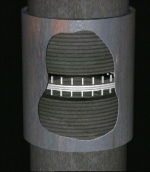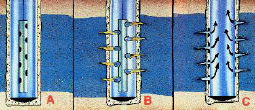June 10, 2002 – Radio frequency identification won’t solve the world’s energy problems, but it could bring new efficiencies to oil drilling. In-Depth has developed an RFID system that that makes it possible to more accurately measure bore hole depths and eliminates the need for hauling expensive equipment to remote sites. It could save oil drillers millions of dollars a year.
In-Depth is a technology development company based in New Orleans. It was set up by Marathon Oil Corp. of Houston a couple of years ago, to explore the use of RFID in wells. “We got interested in RFID because we saw it had down-hole applications to solve some oil and gas well needs,” says Phil Snider, a petroleum engineer and senior technology consultant with Marathon. “We saw ways it could improve operations and reduce costs.”
The company is working on several different RFID applications. One involves firing perforating guns at a precise depth. An oil company typically drills a borehole with a nine-inch diameter to 10,000 or 15,000 feet. It then inserts a casing, or pipe, that is 3.5 to 7 inches in diameter into the hole. It then fills the space between the hole and the outside of the casing with cement for strength.
Oil wells don’t typically suck up oil through the hole at the end of the well, like a straw. Instead, they may drill through several pools of oil trapped between layers of rock. They then have to punch holes in the casing in the area where the pool is. Typically, a driller might put five perforating guns down in a hole and fire only the ones where the oil is and seal off the sections below so the oil can be pumped to the surface.
In-Depth has developed a method of attaching RFID readers to the perforating guns and isolation valves that go down in the hole. Each reader is programmed to close an isolation valve and fire its perforating gun when it reads a particular code. So the driller only has to drop an RFID tag with the right code down the hole to close an isolation vale and fire the right perforating gun.
Earlier this year, In-Depth tested this RFID application by completing a Marathon oil well in Alaska. It was the first commercial job in which the technology — already proven in research and development testing — was used in a well producing oil.
The readers in the wells cost upwards of $3,000 each, but In-Depth says this is still cheaper than the alternative, which is to use a hydraulic line to close the isolation valves and set off the perforating guns. The hydraulic line is a long tube rented from services companies like Halliburton. It’s very expensive to haul the equipment out to remote locations.
In-Depth is developing several different RFID applications. One use it to track casings. The casing sections are typically 40 feet long. The driller today measures the hole’s depth by counting how many casings have been put into the whole. But when you get down 10,000 or 12,000 feet, it’s easy to be off by one or two sections.
“Being 40 feet off could be huge problem,” says Snider. “You are trying to penetrate a pool of oil. You then punch holes in the casing and let the oil flow in. Then you pump it out. But if you are off by 40 feet, you could be in a zone of water.”
In-Depth has worked with tag makers to develop RFID tags that can be put on the casings. It created a white, Teflon ring with prongs. The ring goes in the threaded housing of one casing, and when the other is screwed in, it compresses the prongs to hold the ring in place. The antenna is embedded in the center of the ring.
A reader can be put into the hole and by identifying precisely each section of casing, a drilling company can know exactly how deep the whole is. This system is still in development, but Snider says there are big savings from not needing an electric line – a high-tech cable that takes depth readings – and from better inventory control. “We’re taking dumb iron,” he says, “and giving it a brain.”
In the past, oil drillers had to have specialized casing with special couplings, or connectors, to protect the hydraulic line. By eliminating the need for the hydraulic line, drillers can use standard casings. Which means they don’t have to plan ahead and order special equipment.
“When we drill the well, we can drop RFID tags in and see what the setting is and what we want to do,” says Snider. “The savings are significant because you typically use an electric line several times on the same hole.”
Marathon Oil began looking at RFID back in 1999. It did a proof of concept test with off-the-shelf tags. But the technology has gone through several iterations. Most of the development work involves the packaging of the RFID tags and readers that go in the hole. The reader has to have a special battery pack, so it can last for at least several months while the well is being set up.
The tags are packaged to protect against pressure and heat. They have to withstand temperatures of 300 Fahrenheit and pressures of up to 15,000 pounds per square inch. Because of this, the cost of the tags and readers are on the high end, Snider says. But they should come down as demand increases.
The company received its first patent on Christmas Day 2001, and has four additional patents pending. Other applications are on the horizon from the company, all involving different down-hole applications, according to Snider.
Whether the demand will ever be there is an open question. Marathon set up In-Depth as a separate, company, which hopes to make money by licensing its technology to oil services company. The problem is the oil services companies get millions of dollars in revenues from renting out electric lines and hydraulic lines. They don’t want to lose that revenue.
This is a common problem with new RFID applications. Often it is startups without entrenched interests that develop and market the technology that meets the customers needs and saves customers money. But in this case, the existing services companies may have the clout to prevent In-Dept or anyone else from threatening their business.
“We’re hoping the service companies see value in the technology we’ve created,” says Snider. “We want them to license it and develop it further. But we just don’t know how it will go.”




